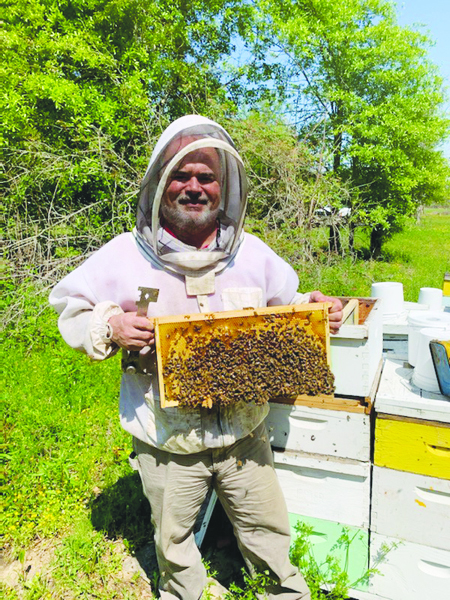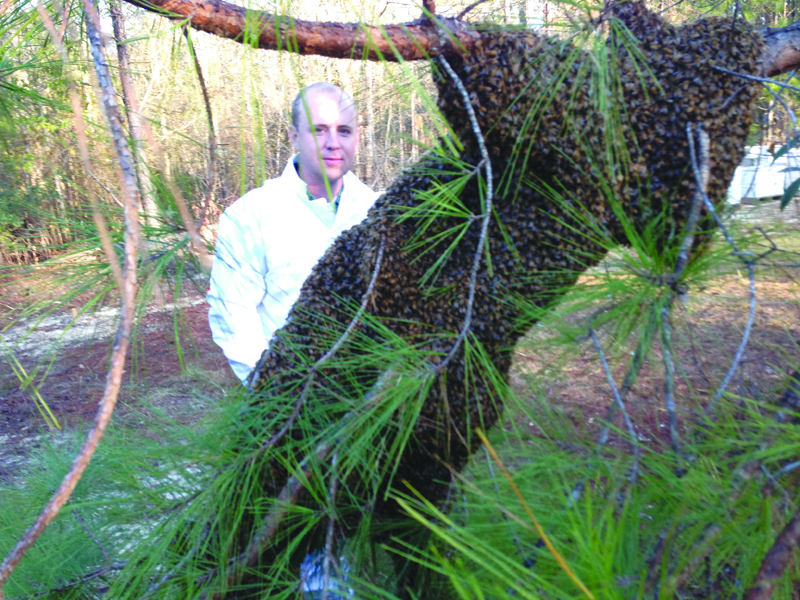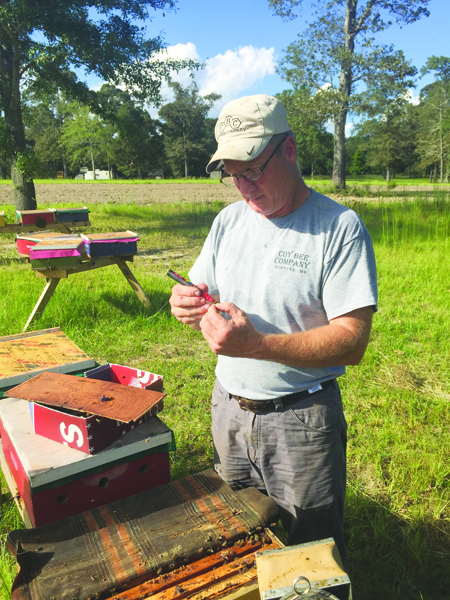Beekeeping is More Than Just a Hobby
By Aimee Robinette
The scientific community calls them tiny miracle workers, but many people see them as pests. However with all the buzzing about and a small but painful, barbed stinger, bees can be a little bit scary. Bees carry out a key action for the planet. Pollination is vital to life on this planet, which is their greatest gift. In fact, a third of the world’s food production relies on these little creatures.
Steven Coy is a commercial beekeeper living in Stove County, but he once brought thousands of hives to the Delta every summer to make honey.
How does one get into beekeeping? “I grew up in a beekeeping family. My grandfather and father started it as a hobby when I was a child and my father had built it into a commercial operation by the time I was thirteen. I was always fascinated with bees and enjoyed the work,” says Coy, who is also the president of the Mississippi Beekeepers Association and an officer in a national beekeeping organization. “As a teenager, I spent my ‘summer vacation’ working on the bee farm as my high school friends would say.
“I worked for my father for twenty years in between college degrees, both a bachelor and master’s, and other jobs,” he explains. “Working with family can be very rewarding but it can be very difficult, and I could not do it anymore. So, in 2014, I started Coy Bee Company with zero hives and equipment.”
Regardless of what he lacked, Coy has been successful and chooses a particular species of bee. “We run Russian Honey Bees, which were imported from Russia by the USDA for their resistance to the varroa mite. They are resistant to Varroa mites and less susceptible to many of the other pests and diseases of honey bees. I am one of the original members – when I worked for my father’s operation – of the Russian Honey Bee Breeders Association.”
For 2021, Coy is starting the season with 1,300 hives. The challenge, he says, is keeping them alive until next year.
“There is no ‘typical day’ in beekeeping. It is a series of events that happens every year. We spend four to six weeks hyper focused on a goal. Once that goal is reached, it’s time to move on to the next. We might do the same job every day for several weeks then move on to the next, but we usually start at 7:00 a.m. and depending on the season we might work until 4:00 or 5:00 in the afternoon or later. I often joke that I only work half days for part of the year. There are twenty-four hours in a day right? So, twelve hours is just one half of a day,” Coy says. “The spring is when we are making new hives. We often work twelve to fourteen hours a day.”
Coy notes that January to April is the splitting season. “Beginning in January and into February we are checking, feeding and assessing each colony. The goal is to increase the population of the hive to maximize the number of divisions (splits) we can make from that colony,” he says. “March to June is the Queen and Nuc season. This is a part of the splitting season but we focus on starting up queen mating nucs and making five-frame nucleus colonies (Nucs) for sale to customers. Here at Coy Bee Company, we produce and sell Queen bees, Nucs (started hives) and honey. We try to balance the production of these three products based on demand and profit.”
Jay White is a commercial beekeeper who lives in Yazoo City. His beekeeper journey also begins as a younger man. “I went to work with my father-in-law when I was nineteen years old,” White says. “At twenty-three, I took a loan out and started my own business. That was in 2003. I had twelve hives and bought 128 from another beekeeper in Arkansas.”
White says he tries to use Italian bees for his operation as they seem to be less aggressive and keep higher populations most of the year.
“White’s Honey and Bee Farm runs approximately 4,500-5000 hives today,” he says. “Every day is full of hours looking into beehives by opening the lid and checking them out. Certain times of year we may be feeding them, other times we add honey boxes during honey flows. We make circles from one yard to another. It takes a lot of time and help to work over 100 bee locations every week.
“Beekeeping today is much more challenging than ever before, hives are harder to keep alive. The constant Mississippi River flooding has killed a lot of the beneficial pollen producing plants, along with the constant battle with parasitic mites, has made keeping bee hives harder than ever before,” he explains. “Finding quality bee locations for almost 5,000 hives is very challenging.”
One typical question is about getting stung. White says that is just part of the job. “We are constantly getting stung. On a typical day I’d say I get three to five stings,” he says. “As long as it’s not right in the face it really doesn’t bother us too much. They seem to always find the holes in your suit for sure.”
White says the most rewarding part of the job is taking a small new beehive in the spring and watching it grow into a flourishing big beehive in the summer. “It makes a big honey crop. We generally make several hundred barrels of honey and sell it to big corporate honey packers all across the United States. Keeping bees is a tough job but I’m very thankful God has put me in this profession. It keeps me outside, it keeps me constantly reminded of the wonders of the Lord, and it keeps me grounded by always knowing that it’s definitely not all honey and no bee stings,” he says.
Andy White, Ph.D, principal agronomist with BASF, is also a beekeeper because of childhood experiences.

Andy White 
The beekeeper examines the frames with honey. Beekeeper holding frame of honeycomb with working bees outdoor. 
Jay White 
Steven Coy
”I was introduced to beekeeping by an Uncle when I was in the 5th grade. He was robbing bees out of a tree and asked me to come along. From that day on I was hooked. I couldn’t get enough of anything related to bees or beekeeping. I read books. I talked to my uncle. I talked to a local beekeeper and thankfully, my parents purchased three hives for me,” White says. “I would sit in front of those hives for hours just watching them work. While in grade school, if a hive swarmed, my mom would call the school and they would allow me to run home to catch them. I really didn’t know a thing about managing a hive of bees other than to add supers in the Spring and let the bees do their thing. I continued to keep a few hives until I graduated high school and left home for college.
While in an undergraduate program at Millsaps, Dr. J.P. McKeown enticed White to study entomology and pursue a graduate degree. “I loved it. When I started graduate school, I managed about fifteen hives and sold the honey to our entomology club at LSU. Back then, beekeeping was easy, and I would usually harvest about fifty-five gallons from those hives and sell it for about $500. That was big money when I was in grad school. Just add supers, collect the honey, and go,” he adds. “I could leave them alone all Fall and start back up in Spring. Things have changed drastically since that time. Varroa destructor, the varroa mite, has changed everything. If they are allowed to grow in a hive unchecked, the hives eventually die.
White, who lives in Holcomb, has three bee yards in his hometown, Itta Bena and Schlater.
“I do not keep as many hives at home as I do in the Delta. I’ve found that bees can produce a Spring crop of honey in the hills but barely enough for them to survive. Dr. Jeff Harris, our beekeeping specialist at Mississippi State, suggested that I try beekeeping in the Delta, so I moved several hives to D&T Farms in Itta Bena,” White explains. “David and Tom allowed me to place them on their farm in a secluded wooded area. From the moment I moved those hives to the Delta, it was like I put them on steroids. I could barely manage their growth.”
White notes that some people might think that placing bees in the Delta near cotton/soybean fields would expose the bees to pesticides, and he says it does.
“However, I haven’t lost any hives because of it except one time when I moved a few very close to a cotton field (my own poor judgment). Most have been lost due to poor nutrition or varroa,” he says.
“For the past five or six years, I was managing about thirty-five hives. A few years ago, a coworker said his dad had lots of old equipment he wanted to sell so I purchased all of it. It had enough boxes and frames to run about 200 colonies. I’m currently up to about 150 which seems like a lot, but it really doesn’t require that much work. Now I’m not saying everyone should go out and buy 150 colonies because you must have experience managing bees.”
In White’s opinion, it’s best to start small with three or four hives and see if you can keep them alive for a year.
“Then start making splits and growing your colonies. Beekeeping is a hobby that I really enjoy. It provides a side income from honey sales. I currently sell honey at various businesses in the area and am always looking for more vendors. The honey from the Delta is special,” he says. “My customers rave about it. To me, it’s like tasting the Delta; warm, sweet, and bright! Recently I’ve started producing Nucleus (nuc) colonies to sell. A nuc is basically five frames of bees and brood with a laying queen.”
Like most beekeepers, White’s day in the bee yard depends on whether he is working for honey production or nuc production. “If I am going for a big honey crop, early Spring work would involve checking each hive for the presence of a queen and the availability of food stores. If colony strength is weak, I may add a frame of brood and food from a strong hive. I am trying to balance the hives so they will all be at their peak when the honey flow gets in gear. I add supers as needed until July when I harvest the honey.
“These supers are placed back on the hives within a couple days of extracting the honey for the summer flow. I rob again in late August and again put one super back on each colony for them to fill with aster and goldenrod honey. After that I may raise a few queens and make splits to increase my colonies. I leave the honey they make in the Fall for them to consume during the winter,” he adds. “In mid to late December, I treat all the hives for varroa. If my goal for the next year is to produce nucs, I start manipulating and feeding the colonies in early February to stimulate growth. I then started splitting the colonies in late March to produce nucs to sell. To me, beekeeping is like farming except I want to grow as many bees as possible for honey and nuc production. There are many more details involved but that would require a book. I am always eager to talk beekeeping with anyone who will listen.”
White says it is also hard to pinpoint which part of beekeeping he enjoys the most because he loves it all.
“Don’t be misled, it is hard work. Lifting heavy supers full of bees and honey while in a bee suit is extremely hot and you will get stung. Just think of lifting a few bags of quickrete wearing a pair of white coveralls in 90-degree weather. And add in a few stings,” he says. “You must enjoy it. Beekeeping has been a tremendous influence in my life and career as an entomologist. If I had known at a younger age of the opportunities available with beekeeping, I probably would have made it a full-time career. However, as I stated earlier, I have been blessed with a career in agriculture and the wonderful hobby of beekeeping.
“ I am blessed to work outdoors. Nothing says or smells like Spring to me more than a hive full of honey bees and freshly tilled dirt. Proverbs 24:13 KJV reads ‘My son, eat thou honey, because it is good; and the honeycomb, which is sweet to thy taste,’” White adds.
